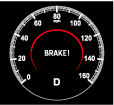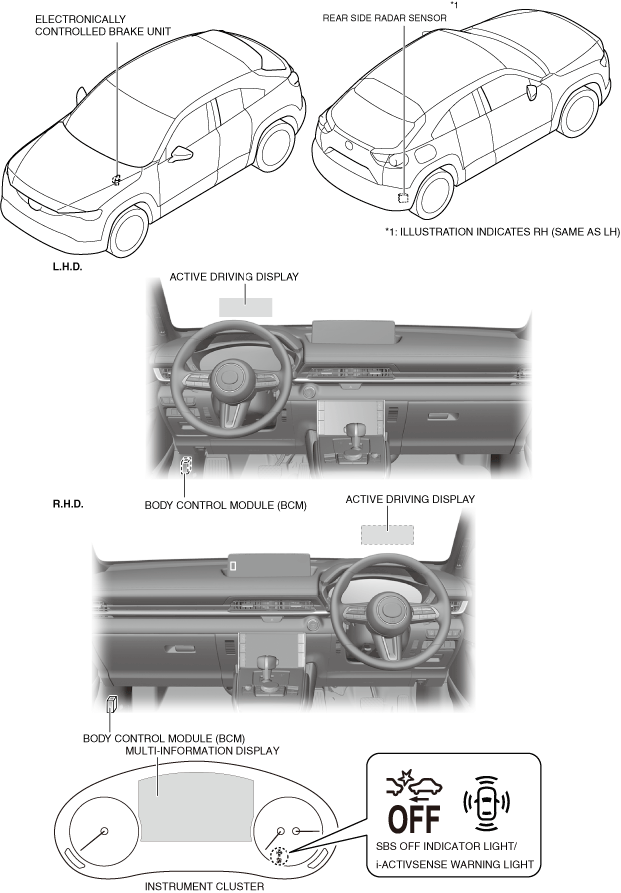SMART BRAKE SUPPORT (SBS) [REAR CROSSING]
id151000015700
Outline
• The smart brake support (SBS) [rear crossing] is a system which detects vehicles crossing at the rear of the vehicle when backing out of a parking space for collision avoidance and damage reduction.
-
Caution
-
• Tires for all four wheels must always be of the specified type and size. If tires other than the specified type and size are used, the smart brake support (SBS) [rear crossing] may not operate normally.
• Do not mix tire types or use tires with significantly different wear patterns on the same vehicle. Use of inappropriate tires could result in the DSC and the smart brake support (SBS) [rear crossing] not operating normally.
-
Note
-
• The smart brake support (SBS) [rear crossing] is designed to assist the driver. The driver's operation always takes priority even while the smart brake support (SBS) [rear crossing] is operating. For this reason, if the driver operates the brakes to avoid danger, the smart brake support (SBS) [rear crossing] operation is canceled.
• When inspecting the vehicle using a chassis dynamometer, turn off the smart brake support (SBS) [rear crossing] using the personalization features to prevent incorrect operation of the smart brake support (SBS)[rear crossing].
Structural view
• The smart brake support (SBS) [rear crossing] uses the rear side radar sensors installed on the rear bumper.
• The rear side radar sensors installed on the rear bumper detect vehicles crossing at the rear of the vehicle.
Function
Brake control
-
• When the body control module (BCM) determines that there is the possibility of a collision with a vehicle moving at the rear while reversing based on target information from a rear side radar sensor, it outputs a brake prefill request signal to the electronically controlled brake unit and performs brake prefill.
-
― Brake prefill
-
• If the body control module (BCM) determines that there is the possibility of a collision with a vehicle at the rear of the vehicle while reversing, the electronically controlled brake unit pressurizes the brake fluid and eliminates the play between the brake pads and disc plates to perform the brake prefill. As a result, braking force can be applied immediately when the driver notices the condition at the rear of the vehicle and depresses the brake pedal.
― Brake control (damage reduction braking)
-
• If the body control module (BCM) determines that there is the possibility of a collision with a vehicle or obstruction at the rear of the vehicle while reversing, the system warns the driver using a warning sound (smart brake support (SBS) [rear crossing])and the indications on the active driving display and the multi-information display and, at the same time, the electronically controlled brake unit operates the brake control (damage reduction braking) which applies the brakes on all four wheels.
-
Warning
-
• The smart brake support (SBS) [rear crossing] operates when certain conditions are met, however, it is not a system that assures prevention of a collision.
• There are limitations to the brake control (damage reduction braking). Always keep a safe distance from the vehicle or obstruction at the rear of the vehicle and depress the brake pedal appropriately while verifying the safety of the surrounding area.
System conditions display
• The smart brake support (SBS) [rear crossing] system notifies the driver of the system status using the smart brake support (SBS) OFF indicator light, the active driving display, and the multi-information display.
Smart brake support (SBS) [rear crossing] display function table
|
Status
|
Smart brake support (SBS) OFF indicator light
|
i-ACTIVSENSE warning light
|
Active driving display
|
Multi-information display
|
|
SBS [rear crossing] system OFF
Main power is switched ON (READY off or on)
|
SBS [rear crossing] system is stopped
|
 |
OFF
|
No display
|
No display
|
No display
|
|
SBS [rear crossing] system ON
|
Possibility of collision with vehicle crossing at rear
|
OFF
|
OFF
|
 |
 |
No display
|
|
Approx. 2 s have elapsed since vehicle was stopped by brake control (damage reduction braking) operation
|
Driver depresses brake pedal
|
OFF
|
OFF
|
No display
|
No display
|
No display
|
|
Driver does not depress brake pedal
|
OFF
|
OFF
|
No display
|
 |
No display
|
|
Abnormality occurred in SBS [rear crossing] system
|
SBS [rear crossing] system malfunction
|
Due to sensor
|
 |
 |
No display
|
 |
 |
|
Due to other cause
|
 |
 |
No display
|
 |
No display
|
|
SBS [rear crossing] system function is stopped temporarily
|
Due to sensor
|
 |
 |
No display
|
 |
 |
|
Due to other cause
|
 |
 |
No display
|
 |
No display
|
-
Caution
-
• If a DTC is stored in the body control module (BCM) by the on-board diagnostic function, the smart brake support (SBS) [rear crossing] is inhibited depending on the cause of the malfunction.
• If DTCs are stored in the electronically controlled brake unit, rear side radar sensors, PCM, or the instrument cluster, the smart brake support (SBS) [rear crossing] is inhibited depending on the cause of the malfunction.
-
Note
-
• With the smart brake support (SBS) [rearward detection] system turned off, the smart brake support (SBS) [rear crossing] is also turned off.
System wiring diagram
Operation
• When all of the following conditions are met, operation of the brake prefill/brake control (damage reduction braking) is allowed, and it operates if the possibility of a collision with vehicles crossing at the rear of the detecting vehicle increases.
-
― Switch the main power ON (READY on).
― Selector lever position is in R position
― Detecting vehicle speed is approx.10km/h {6 mph} or less
― Approaching vehicle speed is approx. 3 km/h {1.9 mph} or more, approx. 30 km/h {19 mph} or less
― i-ACTIVSENSE (advanced safety and driver support systems) warning light is not turned on
― Smart brake support (SBS) [rear crossing] has not been turned off
― No abnormality in DSC system
― No abnormality in rear side radar sensor
― No major malfunction related to other vehicle behavior
-
Note
-
• The smart brake support (SBS) [rear crossing] will operate even if the DSC OFF indicator light is turned on after the DSC operation is inhibited by operating the DSC OFF switch. If the smart brake support (SBS) [rear crossing] operates while the DSC has been inhibited, the DSC transitions to the permit condition and the DSC OFF indicator light turns off.
• If ice, snow, or dirt is adhering to a rear side radar sensor, it may not detect normally. As a result, the smart brake support (SBS) [rear crossing] may not operate normally.
• A rear side radar sensor may not detect normally depending on the travel or vehicle conditions. As a result, the smart brake support (SBS) [rear crossing] may not operate normally.
• A rear side radar sensor may not detect depending on the position of a surrounding obstruction, its shape, or its material. As a result, the smart brake support (SBS) [rear crossing] may not operate normally.
Brake prefill operation
Solenoid valve operation table
|
Pressure feed valve
|
TMC cut valve
|
Inlet solenoid valve
|
Outlet solenoid valve
|
Simulator valve
|
Linear actuator
|
|
LF―RR
|
RF―LR
|
LF―RR
|
RF―LR
|
LF
|
RF
|
LR
|
RR
|
LF
|
RF
|
LR
|
RR
|
|
ON (open)
|
ON (closed)
|
OFF (open)
|
OFF (closed)
|
ON (open)
|
Operation
|
Hydraulic circuit diagram
Block diagram
-
• When a rear side radar sensor detects an approaching vehicle at the rear of the vehicle, it sends target information (1) to the body control module (BCM).
• The body control module (BCM) receives target information (1) and if it determines that the possibility of a collision with vehicles crossing at the rear of the detecting vehicle is high, it sends a brake prefill request signal (2) to the electronically controlled brake unit. At the same time, the body control module (BCM) outputs the warning sound signal (2) to the notification and warning speaker (rear) to activate the warning sound.
• When the electronically controlled brake unit receives the brake prefill request signal (2), it operates (3) the pump motor. At this time, all of the solenoid valves are off and the brake fluid pressure generated by the pump motor is conducted (4) to the caliper pistons on each wheel.
• By conducting the brake fluid pressure generated by the pump motor to the caliper pistons, the clearance between the brake pads and disc plates is maintained in a narrowed condition.
• As a result, if the driver becomes aware of a vehicle or obstruction at the rear of the vehicle and depresses the brake pedal or the driver does not perform an avoidance maneuver and the brake control (damage reduction braking) is operated, braking force is generated immediately and the braking distance is reduced.
Brake control (damage reduction braking) operation
Solenoid valve operation table
|
Pressure feed valve
|
TMC cut valve
|
Inlet solenoid valve
|
Outlet solenoid valve
|
Simulator valve
|
Linear actuator
|
|
LF―RR
|
RF―LR
|
LF―RR
|
RF―LR
|
LF
|
RF
|
LR
|
RR
|
LF
|
RF
|
LR
|
RR
|
|
ON (open)
|
ON (closed)
|
OFF (open)
|
OFF (closed)
|
ON (open)
|
Operation
|
Hydraulic circuit diagram
Block diagram
-
• After the brake prefill operation, if the driver does not perform an avoidance maneuver and there is the danger of a collision based on the target information (1), the body control module (BCM) sends a brake control (damage reduction braking) request signal (2) to the electronically controlled brake unit to operate the brake control (damage reduction braking). At the same time, the body control module (BCM) outputs the warning sound signal (2) to the notification and warning speaker (rear) to activate the warning sound.
• When the electronically controlled brake unit receives the brake control (damage reduction braking) request signal (2), it energizes the linear control solenoid valve, switches the hydraulic circuits, and increases the brake fluid pressure. As a result, the brake control (damage reduction braking) operates (3).
• While the brake control (damage reduction braking) is operating, a brake light signal (3) from the electronically controlled brake unit is sent to the electrical supply unit (ESU) at the same time.
• A brake light status signal (4) is output from the electrical supply unit (ESU) to the electronically controlled brake unit at the same time as the brake lights are turned on.
• While the brake control (damage reduction braking) is operating, a message is displayed on the active driving display. (With active driving display)
• The brake control (damage reduction braking) is maintained in this condition for approx. 2 s after the vehicle is stopped. Thereafter, the driver needs to depress the brake pedal to maintain the vehicle in a stopped condition.


















